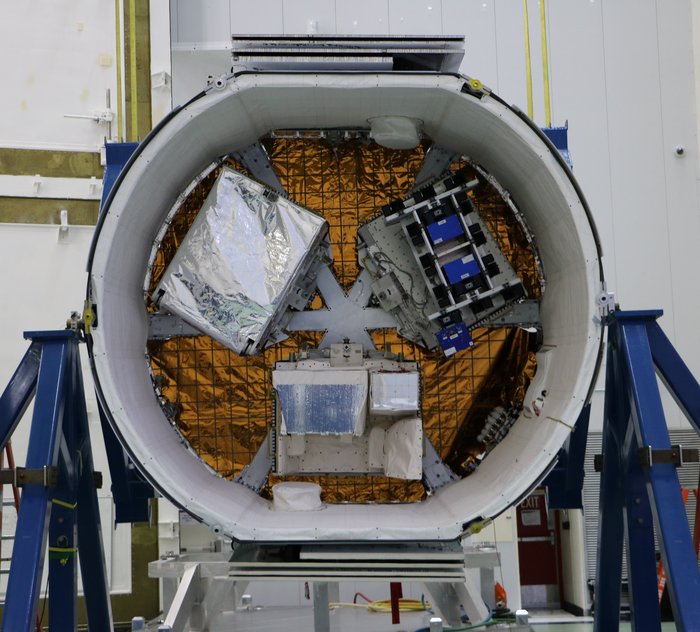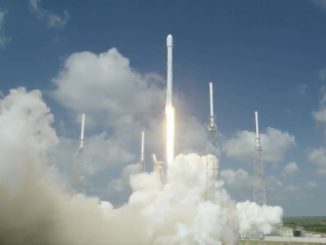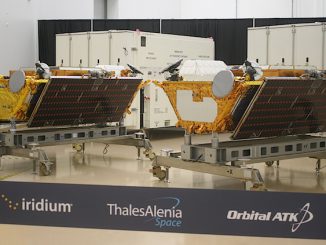
Scientists working on a new lightning detection instrument mounted outside the International Space Station said Tuesday they expect little effect on the sensor’s performance from possible contamination from the upper stage of a SpaceX Falcon 9 rocket that launched it into orbit April 2.
The Atmosphere-Space Interactions Monitor, an instrument developed in Denmark and funded by the European Space Agency, was attached to an observation post outside the space station’s European Columbus lab module Friday, then powered up for a six-week calibration and commissioning campaign.
The science payload was activated sooner than expected, and an initial checkout of computers and sensors was accomplished over the weekend, according to Ole Hartnack, ASIM project manager at Terma A/S, the Danish company that led the technical development of the instrument.
Hartnack told Spaceflight Now on Tuesday that scientists are examining “possible contamination” on cameras that will be used to detect optical flashes associated with lightning.
But the potential contamination on ASIM’s Modular Multispectral Imaging Array — a pair of light-sensitive optical cameras — is not expected to degrade the instrument’s scientific performance, officials said.
“We have been assessing possible contamination of the MMIA cameras from (the) Falcon 9 second stage engine, however, we do not expect any problems or issues at this point based on the information we have received from SpaceX,” Hartnack said. “Furthermore, all cameras do have a decontamination system which can be activated if performance issues will be identified, which to my understanding is not likely for now.”
Torsten Neubert, the ASIM science team coordinator at the Technical University of Denmark, added: “We do not anticipate issues here, because our optical lenses carry decontamination heaters.”
The possible contamination may have come from propellant venting from the Falcon 9’s second stage after engine shutdown.
The 692-pound (314-kilogram) ASIM instrument launched April 2 from Cape Canaveral inside the trunk of a SpaceX Dragon cargo craft, alongside a platform containing materials exposure experiments and a refurbished spare pump for the space station’s coolant system.
SpaceX said in a statement that it has heard of no performance issues on any of the three payloads launched inside Dragon’s trunk section, and the decision to call off a Falcon 9 launch attempt Monday with NASA’s Transiting Exoplanet Survey Satellite was not related to the April 2 launch.
The statement did not say whether SpaceX had studied the contamination concern.
After the Dragon capsule arrived at the station April 4, the research lab’s Canadian-built robotic arm — with the help of its two-armed appendage nicknamed Dextre — extracted the three trunk payloads, one at a time.
It was ASIM’s turn Friday after smooth transfers of the external experiment-carrier, known as MISSE-FF, and the coolant pump to their new homes outside the space station.
The Dextre robot grabbed the ASIM instrument package — about the size of a mini-refrigerator — and pulled it out of the Dragon cargo bay for the move over to ESA’s Columbus module. Ground controllers wanted to get the instrument plugged into power on Columbus within six hours from the time its heaters were disconnected inside the Dragon trunk.
The transfer took about four-and-a-half hours, and Japanese astronaut Norishige Kanai flipped switches inside the space station apply power to the new instrument.
According to Hartnack, ASIM’s initial checkout after power-up occurred as planned.
“We have performed the initial checkout of computers and instruments during the weekend, and everything works fine and as expected,” he said.
Despite the initial contamination concern, the instrument’s optical cameras registered their first Transient Luminous Events, or TLEs, late Monday, Hartnack said.
TLEs are electrical discharges high in the atmosphere above large thunderstorms, often manifesting themselves as red sprites or blue jets and sometimes visible on dark nights, especially from aircraft. Phenomena known as elves are the most difficult to detect, requiring special photographic equipment.

Long theorized with sporadic observations which were spread by word-of-mouth, bright electrical bursts above thunderstorms were first documented in 1989.
In addition to the two light-sensitive optical cameras, ASIM also carries sensors to detect X-ray and gamma-ray emissions from thunderstorms. Scientists hope to correlate the high-energy emissions with simultaneous optical observations of high-altitude lightning.
Scientists know little about how the discharges are triggered, or how they reach so high in the atmosphere, near the edge of space, Neubert said before the April 2 launch.
Lightning processes are slowed at high altitude, Neubert said, making it a good laboratory for studying how electrical discharges emanate through the atmosphere.
“They are really lightning, except they are lightning processes in the upper atmosphere,” Neubert said of sprites and jets. “So they look a little bit different, but if we understand them, we’ll also understand normal lightning much better.”
Scientists also hope to study lightning’s effects on ozone and other gases in the atmosphere during the nearly $50 million (40 million euro) instrument’s two-year observing campaign.
ASIM will point down at Earth from the space station’s 250-mile-high (400-kilometer) orbit, which covers the regions of the planet where most thunderstorms form and strengthen. Parts of the instrument’s payload were also contributed by scientists in Norway, Poland and Spain.

In addition to research into lightning formation and electrical processes above thunderstorms, the European instrument could also detect meteors entering Earth’s atmosphere.
Part of the calibration effort in the coming weeks will involve determining where to set limits in on-board software to decide whether the instrument’s computer should flag an image for downlink to Earth. Scientists don’t want to overload the pipeline of data coming from the space station with too many images.
“Setting the levels will be a matter of trial and error – setting the trigger too low will flood the network with images that are of no use, too high and some thunderstorms will not be recorded,” ESA said in a statement.
Regular science observations should begin by late May.
Email the author.
Follow Stephen Clark on Twitter: @StephenClark1.



